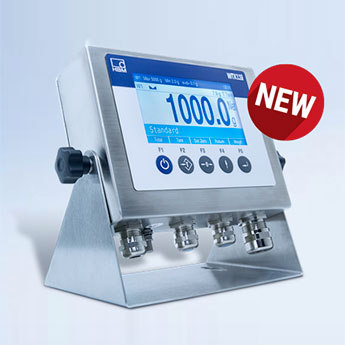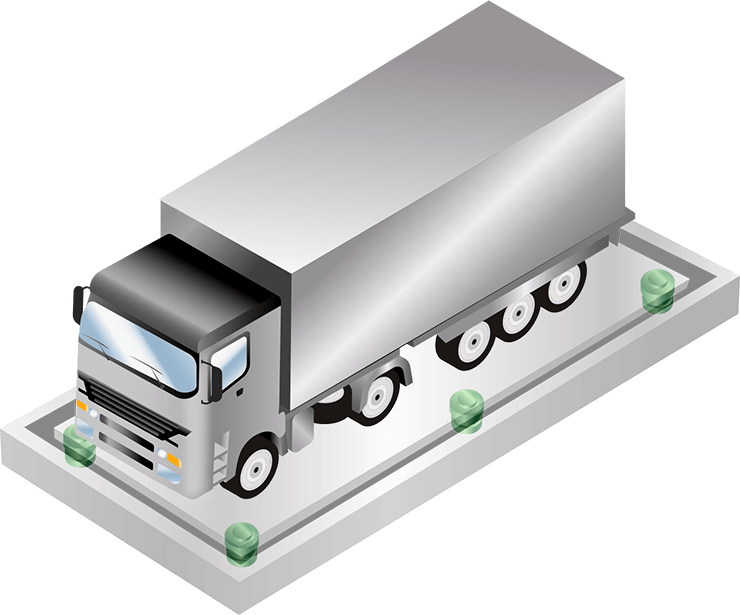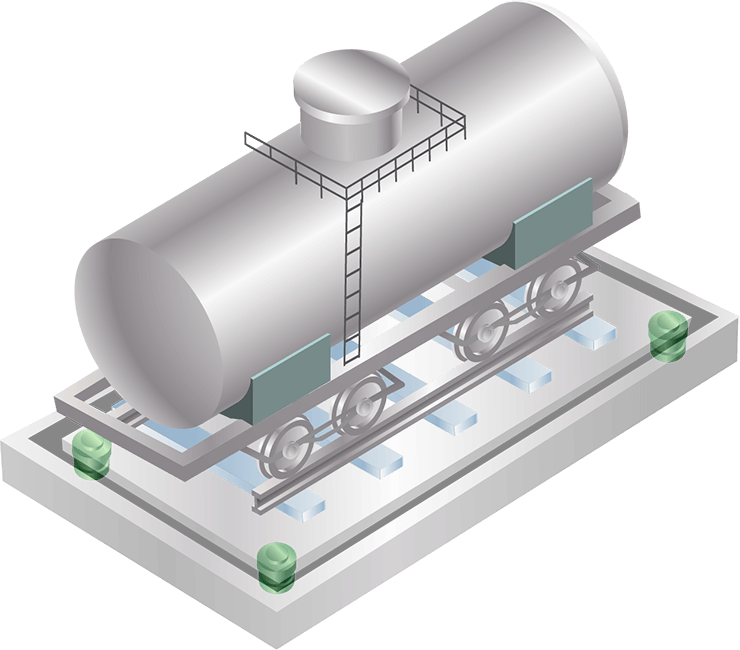Effective and cost-efficient weighing of large objects
How Do Modern Truck Scales Work?
In this age of modern industrialization (Industry 4.0) and the Internet of Things (IoT), electromechanical and hybrid scales are equipped with digital strain gauge load cells, a weighing terminal with digital weight indicator and operator guidance, plus various interfaces for printers, switching contacts, fieldbus and network interfaces, second displays and further additional equipment, all of which enable a largely automated weighing process.
The WTX110 weighing terminal can be combined with any analogue or digital load cell with an RS485 interface for use without losses as a digital measurement chain. The entire scale is easy to put into operation on site using the TFT colour display. An Ethernet interface enables the WTX weighing terminal to be connected to a network, enabling its remote parameterization, visualization and control via the HBM PanelX software. For scale operation, weighing software is then required, which controls the entire weighing process all the way to the preparation of invoices.
Types of weighing machines
Truck scales are usually non-automatic, i.e. they are reliant on operating personnel. Automatic weighing instruments (AWI) carry out weighing operations, including positioning and removing the load, fully autonomously, therefore helping to automate industrial production. However, this type of scale requires special approval and is subject to European Directive 2014/32/EC. Axle load scales are not legal for trade in Germany, and therefore cannot be used for goods traffic. Consequently, they are only used for checking. All-in-one truck scales are used for weighing most vehicles, and can be either in floor-mounted (flush with the ground) or over floor-mounted.
The history of truck scales
The history of truck scales begins with industrialization and the increased flow of goods and heavy goods transport this brought about. Goods were placed on the scale by hand right up until the 18th century was well underway. As this work was manual, the goods could not weigh more than 500 kg, which was the weight of a common container in those days.
Since the middle of the 20th century, mechanical weighing machines are gradually being superseded by electronic and hybrid scales. Load cells based on strain gauges (SG) are becoming more prevalent, and have in fact been the technical basis of truck scales since the mid-1990s.
Truck scales can be either pit-mounted or surface-mounted. Surface-mounted scales can be adjusted without a problem and are more easily accessible for cleaning and maintenance. However, they are also more prone to damage than truck scales, which are flush with the ground and can also be traversed obliquely, generally making them the scales of choice for long-term use on factory premises.
Truck scales are available in reinforced concrete or steel. To prevent measurement errors, off-centre load compensation must be performed before the scale is put into operation. Here, reference weights are placed on all weighing points of the scale and a conformity assessment is performed. In addition, the scales are then gradually subjected to more and more weight, up to maximum load. This minimizes scale measurement errors due to one-sided loading during subsequent operation.
Using truck scales
There are different options for operating truck scales. Firstly, the vehicle is driven onto the scale. The driver can then initiate weighing him/herself via the operator terminal or control cabinet. Various identification methods are available (e.g. a mobile device or barcode) for pairing the weighing operation with an order and preventing unauthorized manipulation. Furthermore, the vehicle number plate is recorded and paired with an order using camera and/or sensor-based position monitoring.
These days, it is also possible to remotely control scales from an office building, for example, using large displays that are actuated by encrypted data communication, for instance.
Methods of measurement
In modern truck scales, weight is measured with the aid of load cells such as RTN or C16i from HBK. For legal-for-trade use, these analogue or digital load cells must satisfy certain basic conditions and be installed in conformity with the applicable guidelines for Europe (WELMEC 2.4). Strain gauge load cells are commonly used. When a load is applied, the load cell – which acts as a spring element – deforms, causing an electronically measurable change in resistance on the load cell’s strain gauge. This is transmitted to an electronics such as a weighing terminal, processed and shown on the display as a weight figure.
Nowadays, use is frequently made of digital load cells that enable conversion to a digital signal in the actual cell. To achieve this, a small amplifier board is integrated into the load cell, which is then hermetically sealed. The amplifier then converts the analogue strain gauge signal into a digital and therefore considerably less noise-sensitive signal in the load cell itself. This eliminates interference due to influences acting on measurement channels, and also largely prevents manipulation of the sensor signal.
Measurement accuracy
As commercial, medium accuracy weighing machines, truck scales must conform to accuracy Class III, as set out in the German Measures and Verification Ordinance. Accuracy is based on relative resolution, i.e. the quotient of maximum load (max) and the smallest resolved weight value, the verification scale interval e (=d).
Table of accuracy classes for scales
| Class | Scale intervals | Minimum load | Number of scale intervals | |
| min | min | max | ||
| I | 0.001g < e | 100 e | 50000 | – |
| II | 0.0001g < e < 0.05g | 20 e | 100 | 100000 |
| 0.1g < e | 50 e | 5000 | 100000 | |
| III | 0.1g < e < 2g | 20 e | 100 | 10000 |
| 5g < e | 20 e | 500 | 10000 | |
| IIII | 5g < e | 10 e | 100 | 1000 |
The error tolerances of a legally verified scale are established by the International Organization of Legal Metrology (OIML R76) and have been incorporated in Directive 2014/31/EU.
Moreover, measurement accuracy always also depends on ambient conditions and proper scale operation and maintenance. Precise and rugged load cells equipped with overload protection and off-center load compensation reduce the risk of inaccurate measurements. With digital load cells, off-center load compensation can be conveniently adjusted via the integrated display and keypad of the WTX110-D weighing terminal.
Legal verification of truck scales
For legal-for-trade applications, scales require mandatory legal verification to guarantee the accuracy of measurement results and to protect consumers. This, therefore, applies to most truck scales. Only a few sectors are not subject to domestic legal-for-trade obligations. Here, different regulations apply, such as the SOLAS Convention for shipping companies.
Scale manufacturers must carry out a conformity assessment/initial verification of the scale in readiness for legal verification by the competent Standards Office. In addition, since 2015 there has been an obligation for plant operators to register new and reconditioned measuring instruments with the competent Standards Office within six weeks of bringing the scale into operation.
Conformity assessments become invalid after three years (in Germany, less time in other countries), and the scale must be verified by the Standards Office again if it is to legally remain in operation.






